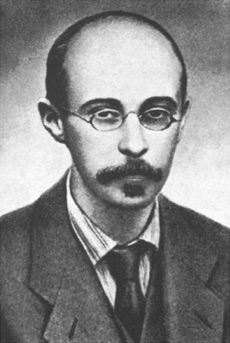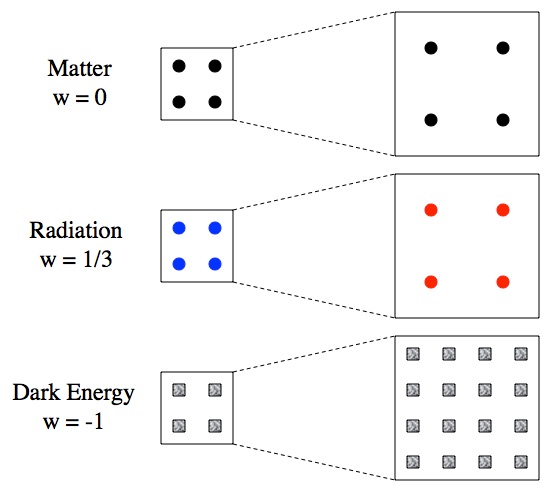Physicist: The universe is expanding and the rate of that expansion is accelerating. If the universe were full of only matter (both regular and dark) and energy, then we’d expect that the expansion would be slowing. Dark energy is the thing that is responsible for that acceleration. Now as for what exactly that thing is: we have interesting and vaguely informed guesses.
Back in the day Einstein came to a few realizations after he spent some time thinking about falling elevators and rockets. This lead to a way of describing the nature of gravity (falling and whatnot) in terms of the geometry of spacetime and a relation between that geometry and the amount of matter and energy that’s around. Einstein’s field equations can be used to describe how time and space are influenced by the presence of big chunks of matter like planets and stars, manages to explain/predict Mercury’s weird orbit and a bucket of other stuff, and has passed every test it’s been put to with flying colors. That last bit is important: it’s easy to come up with crazy new theories, but hard to come up with theories that precisely predict results that were not previously understood.
Enter Friedmann, who happened to be thinking about the entire universe one day. Einstein’s field equations related mass/energy with the shape of spacetime. So, pondered Friedmann, what happens when you apply those equations to the universe as a whole? First he assumed that space can expand or contract over time (why not?), then he threw that assumption at Einstein’s field equations to see if they’d stick. Somewhat surprisingly, this is easier than it sounds.

Mr. Алекса́ндр Алекса́ндрович Фри́дман (Alexander Friedmann), a man who looks exactly like you’d hope he would.
On a totally over-the-top-large scale (billions of lightyears) the matter and energy of the universe is distributed roughly uniformly. On this scale we describe the matter and energy in the universe as the “cosmological fluid”, because on the largest scales even the largest clumps of matter are as indistinguishable as atoms in water. These “largest chunks” (as far as we know) are galactic super clusters; ours is about half a billion lightyears across and there are possibly many millions of super clusters in the observable universe. And that’s only the observable universe. Guessing the size of the entire universe based only on the part of it that we can see is like trying to guess the size of the Earth by standing in a featureless open field.

So you’re somewhere. How big is it?
Words utterly fail when trying to describe how much “out there” is out there. Point is: all that’s important for figuring out the behavior of the universe as a whole is the average density of matter and energy, which is roughly the same everywhere. You don’t need to stress about every star and galaxy in the universe, or even about the size of the universe as a whole, any more than you need to stress about every grain of sand in a pile of sand.
When Friedmann said space can expand or contract over time he said it this way: . That’s the spacetime interval (which is how distance is measured in spacetime) with the addition of a scaling term, a(t). If a(t) doubles, that means that the distance between any two points in space has doubled. So, if you figure out how a(t) changes over time, you can describe how the universe is expanding or contracting over time. Incidentally, a(t) also describes the cosmological redshift of light; if a(t) doubles between when some light is emitted and absorbed, then the wavelength of that light (like the space it’s traveling through) will double and longer wavelengths mean redder. The oldest light in the universe was emitted when a(t) was about 1100 times smaller than it is now.
It turns out (this is not obvious) that Einstein’s equations dictate that , where w is the weirdly named “equation of state” and k is a constant number.
and
for a universe filled with radiation (light, neutrinos, and matter moving near light speed).
and
for a universe filled with regular matter (including you, your stuff, basically everything else, and dark matter too). In both of these cases the universe expands, and the rate of that expansion slows down, forever.
As space expands the density of matter and radiation decreases, because there’s more space for it to be spread out in. But radiation not only gets more spread out, but redshifted as well and that means that the energy density of radiation drops faster than the energy density of ordinary matter. So, we can expect that w, which describes a combination of both matter and radiation, should be somewhere in the range . Since the expansion of space decreases the energy density of radiation more than matter, over time w should drift closer to 0 as matter becomes more dominant.

The expansion of space decreases the energy density of matter by spreading it out and decreases the energy density of radiation by spreading it out as well as redshifting it. But the expansion of space doesn’t decrease the energy density of dark energy; instead it just seems to create more
But here’s the thing! Since the late 90’s we’ve been able to show that the expansion of the universe is speeding up, not slowing down. In order for that to happen the equation of state of the universe must be . This came as a bit of a shock to cosmologists. But being brow-beaten by experiment and observation is what good science is all about. Onward.
Upon closer examination of the expanding universe we find that including “stuff” with the equation of state w=-1 is a good fit. This corresponds to a uniform negative energy with a constant density. There are a couple of things about that which are… a little strange. A constant density means that as space expands there’s more of this stuff around. Matter and radiation are indeed being thinned out more and more by the expansion of the universe, but this very bizarre new stuff doesn’t get thinned out. The fact that it has negative energy is just icing on the weirdness cake.
Not knowing what else to call it, physicists have dubbed this uniform, undiluting, negative-energy stuff “dark energy”. That’s not to say that we have any idea what it is, but that’s no reason to not give something a name. Unfortunately, dark energy and dark matter are difficult to study (hence the names) so it’s tricky to figure out exactly how much of each is around, but of the energy and matter around today roughly 75% is dark energy, 20% is dark matter, and 5% or less is regular matter. Over time the percentage of dark energy should approach 100% as the expansion of space waters down all of the matter and radiation.
We can infer the existence of dark matter in large part because models of the universe that take it into account do a good job of describing the observed evolution of the universe, while models that don’t take dark energy into account do a terrible job. Because the amount of dark energy seems to be proportional to the amount of space around, it seems fairly reasonable to say that dark energy is the “energy of empty space”. What in the hell that’s supposed to mean is now a lively topic of discussion and debate. There are a bunch of theorists and experimentalists running around trying to directly detect and/or describe dark energy, and with any luck they just might do it.







40 Responses to Q: What is dark energy?